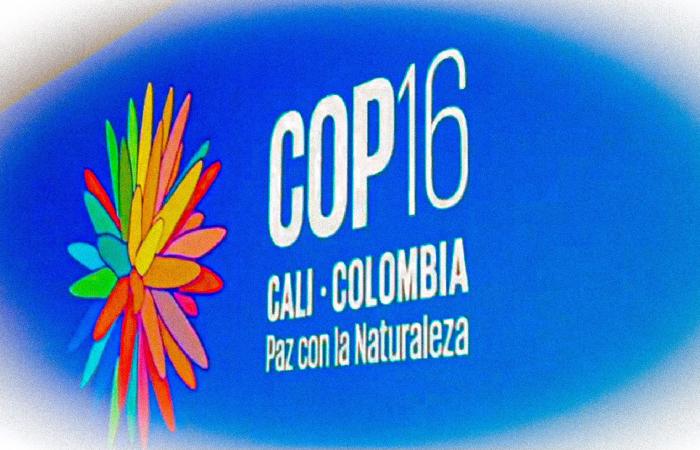From Monday October 21 to Friday November 1, heads of state, diplomatic delegations and representatives of civil society are expected in Cali, Colombia, to find an agreement to combat the erosion of biodiversity. Natura Sciences discusses the six major issues of this conference.
Two years ago, COP15 was the scene of the historic Kunming-Montreal agreement. States have committed to objectives to reverse the trend towards the extinction of species. “COP16 must now be a springboard COP, to find out how to concretely achieve these objectives. This is a moment of truth about the ambition of States”explains Juliette Landry, head of research on the international governance of biodiversity at the Institute of Sustainable Development and International Relations (Iddri).
The conference will once again bring together the 168 signatory countries of the Convention on Biological Diversity (CBD), the international treaty adopted at the Earth Summit in Rio de Janeiro in 1992. Among the notable absentees from this treaty are the United States. United, which never signed it. Return in six questions on the issues that structure COP16.
No. 1: Will countries respect their commitments?
The 168 signatory states of the International Convention on Biological Diversity committed at COP15 to publish national action plans for the protection of biodiversity before COP16 in Cali. The aim of these roadmaps is to detail how each State will tackle the problem of the disappearance of living things.
But as the conference begins this Monday, October 21, 85% of countries had not yet done so as of October 15, according to English-speaking media The Guardian and CarbonBrief. Only 21 countries and the European Union had presented their document. A figure that has evolved in recent days, since several states have presented their plan in the last few hours. On the first day of the COP, 32 countries and the European Union published their roadmaps, making countries’ ambition difficult to assess.
Around a hundred countries have also published “ national targets ». The agreement provides for these less complete documents, in particular for countries with little research capacity. As for the French diplomatic corps, we want to be optimistic. “Other states should also take advantage of the COP to publish their national plan“, says a source within the Ministry of Ecological Transition.
No. 2 – Will the question of financing block the agreement?
This is surely the point on which there will be the most tension. To combat the erosion of biodiversity, COP15 set a global objective of investing $200 billion per year in public and private funding. Of this total envelope, developed countries have committed to providing “ at least $20 billion per year by 2025, and at least $30 billion per year by 2030” to developing countries. In addition, States have committed to gradually eliminating or reforming funding “ harmful » to biodiversity to the tune of 500 billion dollars per year.
Read also : For IPBES, the economic system leads to the fall of biodiversity
These two actions combined should make it possible to almost completely address the financing gap. According to a study carried out in 2020, the financing needed to fight against the collapse of ecosystems between 722 and 967 billion dollars each year until 2030. It was around 130 billion dollars in 2019, according to the same study.
The countries of the South want to obtain the creation of a new fund specially dedicated to this issue. But the countries of the North, including France, do not want to go down this path. They argue that a nature protection fund already exists: the Global Environment Facility (GEF). The latter says he has mobilized $8.6 billion in direct investment and $36 billion in co-financing in 18 years. Within this institution, a branch specifically linked to biodiversity, the Global Biodiversity Framework Fund (GBFF), was created following COP15.
The countries of the South argue that in two years, only 260 million dollars have passed through this route. Contacted, the French Ministry of Ecological Transition said “not wanting to create a fund at each conference. Our goal is the efficiency and improvement of existing instruments.”
No. 3 – To what extent will Latin American countries be the driving forces of this COP16?
For the first time in the history of the COP on biodiversity, heads of state are expected to make the trip. In particular the leaders of Latin America such as Brazil, Honduras, Panama and of course Colombia, the organizing country. The new president of Mexico Claudia Sheinbaum, a former IPCC scientist, could also be present.
Read also : 5 key lessons from IPBES on invasive alien species
They will be alongside African leaders, such as those of Ghana and Guinea Bissau. “This allows us to see that this COP16 is important for developing countries, a little less for developed countriess,” observes Juliette Landry. France will be represented by the Minister of Ecological Transition Agnès Pannier-Runacher.
The Brazil-Colombia axis seems particularly committed. These two countries have recently shifted to the left, with governments making strong statements against deforestation in the Amazon and for the rights of indigenous peoples. They use it as a diplomatic tool on the international scene. Brazilian President Lula da Silva has been pleading for months at international summits for a “bioeconomy”.
N°4 – What results for the coalition led by France and Costa Rica?
The Coalition of High Ambition for Nature and People, led by France and Costa Rica, has 119 members. She wants to push for the implementation of the 30×30 objective, which aims to protect 30% of land areas and 30% of maritime areas by 2030.
Read also : New alliance wants to protect 30% of land and oceans
This objective was adopted at COP15. But this time it will be a question of defining the rules governing its concrete implementation, in particular concerning international waters which do not belong to any country.
No. 5 – Will there finally be an agreement on digital sequencing information?
This is a topic of discussion that has come up since 2010 and the Nagoya Protocol. How can we achieve a fair sharing of genetic resources? The latter mainly come from countries known as “ of the South »because they are home to a large part of the world’s biodiversity. But these are the so-called “ you North » who benefit from it, for example in the pharmaceutical industry. At the same time, genome banks have developed, depriving Southern countries of access to revenue sharing.
The idea that has emerged in recent years is the creation of an institution which would bring together all the DNA data identified. Companies should pay for access, in order to remunerate the countries of origin of the resources. The French delegation says it supports such an initiative, on one condition: that access to this institution remains free for public research.
No. 6 – Will the security of the event be ensured?
In Colombia, rebels have been confronting the army for years. It is a dissident branch of the Farcs, a communist guerrilla force, which this time threatened the international conference. On X, formerly Twitter, they invited “ delegates from the national and international community to refrain from attending COP16. » The group had, however, announced a truce in its military operations during the event. But Colombian armed forces launched a military offensive against rebel strongholds on October 12. This did not fail to rekindle hostilities.
Colombian President Gustavo Petro wanted to be reassuring for the conference. “The security of the COP is guaranteed”he said to the 12,000 people expected in Cali. The state announced it would deploy 10,000 police forces and 1,600 members of the national army.







